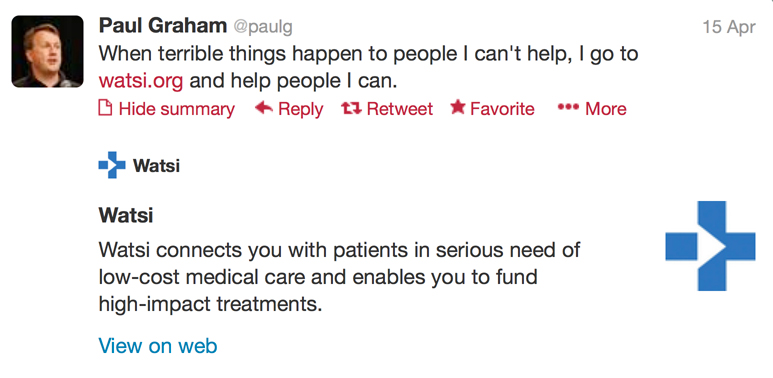Well, there’s nothing like a little controversy to wrap up a year.
Unless you’ve been living under a rock, you probably know all about the recent shitstorm over Paul Graham and his interview with The Information. For those of you blissfully under your rock, here’s the rundown:
- First, The Information posted the edited transcript of an interview staff writer Eric Newcomer did with Graham.
- Then, Valleywag published a story full of indignation and accusations about Graham being sexist.
- Twitter exploded with the rage of angry, tweeting feminists.
- There were a few posts over the weekend dissecting the whole issue. Here’s ours, and here’s one we love from Fred Wilson.
- Today, first Graham then Lessin wrote their own responses to the controversy and to each other.
This whole issue has been centered on whether or not tech is a sexist industry. Age-ism and sexism have been debated again and again, which is awesome. Hopefully the dialogue will actually get us somewhere.
Another focal point of the story is the state of modern journalism. Portions of both Graham’s and Lessin’s posts address this issue and provide the perfect example of the era of new media.
Graham’s Post
Graham says that the context for the interview was to get comments on a feature about his wife, Jessica Livingston. In his view, this misunderstanding led him to respond differently. “In a conversation you stop explaining as soon as the other person’s facial expression shows they understand. In an interview…you don’t have that real-time feedback, so you have to explain everything completely,” he wrote.
Two statements, according to Graham, were especially affected by the interview/conversation distinction. First, he takes issue with the fact that The Information edited out the word “these” from this commentt:
We can’t make “these” women look at the world through hacker eyes and start Facebook because they haven’t been hacking for the past 10 years.
Graham says that he meant a subset of women–specifically women who aren’t already programmers. That sentence was in response to a question about whether YC should train its women founders to be hackers.
“We” doesn’t refer to society; it refers to Y Combinator. And the women I’m talking about are not women in general, but would-be founders who are not hackers.
I didn’t say women can’t be taught to be hackers. I said YC can’t do it in 3 months.
The second comment, and the one that Graham says bothers him the most, is the idea that programmers have to start young or they won’t be successful. He explains it like this:
I was explaining the distinction between a CS major and a hacker, but taken in isolation it sounds like I’m saying you can’t be good at programming unless you start as a kid. I don’t think that In fact, I err on the side of late binding for everything, including metiers. What I was talking about here is the idea that to do something well, you have to be interested in it for its own sake, not just because you had to pick something as a major.
Lessin’s Post
After Graham posted his view, The Information editor-in-chief Jessica Lessin responded on her personal blog. The Information is a new subscription publication that is seeking to reach tech professionals. It’s only a few weeks old, but Lessin spent 8 years covering tech and Silicon Valley for the Wall Street Journal, so she’s no newbie.
The upshot of Lessin’s rebuttal is that they did in fact originally interview Graham for a feature on his wife. However, the interview ended up covering so many topics that they later decided to publish the whole thing on its own. According to Lessin, they got permission from both Graham and his PR person and provided them with a transcript, which they ok’d.
She defended The Information’s policy like this:
On the record discussions with journalists are exactly that: on the record, meaning the material may be published. It is very common to use parts of older interviews in related stories, sidebars or even stories in the future…The Information will always go a step further and follow up and let you know when we plan to use the on-the-record comments.
The Era of New Media
“On-the-record” means “on-the-record,” and it always has. The practice of using quotes in other stories–and even out of context, intentionally or not–is as old as journalism.
The problem, of course, is that journalism has changed dramatically. In the age of Twitter, any one sentence can be pulled out of a greater conversation, skewed a little, and then find its way around the world. And, just like ugly rumors in high school, the truth rarely proves so viral.
Graham found that out with his whole women hacker thing. He felt the sentence was taken out of context and the meaning completely changed by the exclusion of “these.” Whether it makes that much of a difference or not, Graham received a lot of backlash for an opinion he doesn’t hold.
No one has really found an answer to this yet, and, because this new era also thrives on pageviews, plenty of publications don’t really care about the problem.
As for Nibletz, there are a few things sources can always expect from us:
- If you tell us “off-the-record,” you will never see your comments in the pages of our site.
- When we plan to publish a story that spins off the reason for an original interview, we’ll let you know.
- If we make a mistake or misquote, we will update the story with a correction and a note pointing out the mistake.
Ultimately, we strive to be the voice of startups everywhere else. As humans, we’ll make mistakes, but we’ll always attempt to report with integrity and honesty.
Paul Graham learned, again, that nothing we say is safe, even when honest journalists work hard to get quotes right. Social media and the pageview game have changed the industry too much.
Needless to say, 2014 should be an interesting year.









